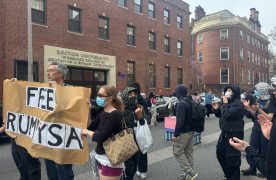The New York Times Magazine piece “Who Is the Bad Art Friend?” has gained a lot of traction in recent weeks. The piece recounts a long legal battle between Boston-area writers Dawn Dorland and Sonya Larson.
The gist of it is as follows: Dorland donated her kidney and created a private Facebook group to document her journey. One of the people in this group was Larson, who did not seem overly invested in Dorland’s kidney donation, much to Dorland’s confusion and seeming annoyance.
Larson then went on to write a short story partially inspired by Dorland’s kidney donation, in which the main character is framed as boastful, clueless and self-centered.

In the private Facebook group, Dorland had posted a letter she’d written to her kidney recipient. Larson’s short story had the main character write a letter similar to Dorland’s. In fact, Larson’s first draft of the short story contained Dorland’s original Facebook posting, preserved to the letter. Dorland read Larson’s story and filed a lawsuit.
The rest is history.
The piece brings up ethical questions about who owns their experiences and ideas. Takes on the debacle have proliferated throughout the media landscape, from discussions on the grievous state of the writing economy in which two writers have to fight over the scraps of a kidney donation story, to a piece on the importance of bragging about kidney donations due to the organ shortage.
There are also legal and journalistic issues in this case. Should creative fiction writers, for instance, be held to some of the ethical standards practiced by journalists when taking direct inspiration from other people’s lives?
As journalists, we have to contact anyone mentioned in the article by name before it is published, and we need permission from sources to have their statements be on the record. Larson did not notify Dorland that she was writing a story inspired by her before she shared it with the public.
But, one could argue, Larson is a creative writer. Creative inspiration is more nebulous and allows for more of a grey area. How can we have any chance at great art if we are circumscribed to writing about the things that happen to us? Moreover, aren’t the things that happen to other people in our lives just as fair game in fictional storytelling, even if this information is shared through a private social media group?
The legal battle here is not much more clear-cut, but it nonetheless provides some steady ground as to how to wrestle with this conflict. Plagiarism is one of the few legal areas where creative writing is circumscribed, and it is what Dorland’s case hinges upon. Perhaps the eventual legal ruling that comes out of this case may provide further guidance as to what the boundaries are in this arena.
But another less touched upon point — albeit perhaps, less important — is how this case reminds of the ethical questions that sprung up after the Harry Styles fanfiction “After” was published.
“After” is now a relatively popular film and book series, but it began in 2013 as a One Direction fanfiction by an author named Anna Todd. She wrote of a college freshman named Tessa who falls in love with a tormented, emotionally abusive version of Harry Styles. By 2014, the story reached 1 billion reads, which then led to Todd securing a book deal.
In the published version of the story, all the One Direction characters’ names were changed. Harry Styles became Hardin Scott. This, perhaps, got rid of the question of copyright.
It could be argued that Styles, as a public figure, is more justifiably a source of inspiration than a relatively private figure like Dorland. But the function of celebrity does not necessarily remove a person’s right to their identity.
Styles has never expressed his opinion on the “After” series. But his fans took issue with Todd’s portrayal of the singer, launching a Change.org petition against the production of the novel’s film adaption, saying Todd allegedly framed Styles as a “verbally abusive punk.”
It could be said that the fanfiction was thus overly transformative. Whereas Larson’s piece did not effectively conceal Dorland as the source of inspiration, Todd’s “After” allegedly veers too far away from the source material in making the character modeled after Styles, according to some interpretations, emotionally abusive.
The case of utilizing a character inspired by Harry Styles in a fanfiction-turned-romance novel and the case of allegedly using someone’s kidney donation as a source of inspiration in a short story touch on different sets of issues with varying levels of seriousness. But the two nonetheless explore how fiction functions as an interpretive force — in one case, overly transformative, and in the other, not transformative enough.
When it comes to creative writing, we may never really know what the boundaries of real-life inspiration are. But it is interesting nonetheless to consider these ethical questions.
It is important to question not only our relationship to the texts we consume, but these texts’ relationship to their subjects, and vice versa. If pens are as mighty as surgical instruments, it is worth weighing their reference points.















Dawn’s original letter was not to the person who would get her kidney. There is a big reddit threat about why this is important to understanding the letter. https://www.reddit.com/r/TrueLit/comments/q7mt2e/an_addendum_to_the_bad_art_friend/